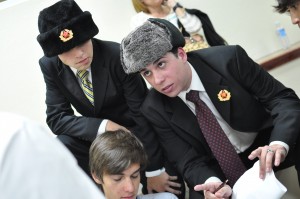Chairing a crisis committee is like going to war. It’s active, it’s constantly evolving, and it can sometimes feel uncertain for delegates. While the key to running a successful crisis committee might seem to be having the right dais or crisis directors, a way to guarantee that the committee runs smoothly and can keep up with the speed of a crisis situation is leaving some of the decisions in hands of the delegates. Now, I know this may seem a little unconventional, but to leave some of the power in the hands of the delegates can grant the dais the ability to both create an environment of crisis in the committee and evaluate the delegates’ preparedness and ability to conduct a crisis as well. Now, you’re not leaving the entire committee in your delegates’ hands, a few guidelines are to be followed:
1. Write a strong briefing paper
A good briefing paper can lead the delegates towards what you want the committee to unravel into. A good crisis briefing should include: historical background, the time and setting of the beginning of the crisis, and a few guideline questions for the delegates to follow. A crisis briefing should not, however, include too much information, so that delegates may be evaluated for how prepared they are. It should also not include the outcome that “will come of the crisis”, since this should be decided in committee by the reactions to the crisis. For example, say the committee is a historical military crisis committee on the Spanish Civil War, it should include some historical background, the sides/countries involved in the war, and the beginning time/place of the first attack.
2. Prepare about 3-5 broad crisis
The dais should have from 3-5 broad crisis communiques to declare during the committee. This will ensure that the dais holds control of the overall direction that the committee will take. The communiques should not be too detail, and they should involve as many delegations as possible in it, to grant the delegates the opportunity to interact in the crisis.
3. Allow the delegates to write “reaction communiques”
This is a tactic that not many chairs use during their committees, but that has proved to be successful in crisis committees. Based upon the 3-5 broad communiques that the dais prepares for committee, allow the delegates to write brief, to the point communiques that include decisions or actions that the delegation that submits them want to add to the crisis. The “reaction communiques” have proven to be more successful when written on separate sheets of paper and passed along to the dais, from there, the dais has the right to decide whether the communique is adequate for the crisis (not too radical, not a point of counter-debate, etc.) and will then share it with the committee. For example, on the same topic of the SCW, the dais declares in their communique that the Republican party takes Madrid, and the delegation of the National Defense Council sends a “reaction communique” that says that they will send 15,000 troops to the border of Madrid in order to counter the attack or stop incoming troops.
4. Interactions with guest speakers and “game changers”
Another good tool to have in crisis committees is guest speakers. Whether “historical characters” or modern leaders, the interactions between the delegates and the guest speaker allows them to now incorporate that persona or organization into their communiques and debate. Another way to keep your committee active is to throw what I call “game changers”. Game changers are certain crisis communiques that make delegates think on their feet and react to an unforeseen crisis that forces them to use their knowledge of the committee topic and think of creative ways to solve the imminent crisis.
5. Create an environment of “controlled chaos”
If you are able to access your committee room before the beginning of the conference, or at least before the committee starts, a good way to make your committee seem more active is to make it look and feel like a crisis room. Maps of the regions, propaganda posters, flags, even different lighting can make a room feel like a more intense environment for the delegates, some may even use them as props in their debate. Encourage your delegates to bring thematic accessories like military hats/jackets, or their own propaganda to hand out.
While these are only a few tips on how to successfully chair a crisis committee and keep it interesting and active, the overall goal is to get delegates to be creative, to think on their feet, and to think outside of the usual paradigms of crisis committees.





